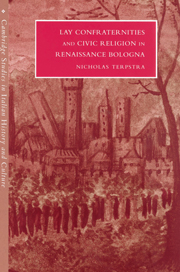Book contents
- Frontmatter
- Contents
- List of figures
- List of tables
- Acknowledgments
- Preface
- Prologue
- 1 The early quattrocento: confraternities, observance movements, and the civic cult
- 2 Lay spirituality and confraternal worship
- 3 The mechanics of membership
- 4 Communal identity, administration, and finances
- 5 Confraternal charity and the civic cult in the late fifteenth and early sixteenth centuries
- Epilogue
- Bibliography
- Index
2 - Lay spirituality and confraternal worship
Published online by Cambridge University Press: 24 September 2009
- Frontmatter
- Contents
- List of figures
- List of tables
- Acknowledgments
- Preface
- Prologue
- 1 The early quattrocento: confraternities, observance movements, and the civic cult
- 2 Lay spirituality and confraternal worship
- 3 The mechanics of membership
- 4 Communal identity, administration, and finances
- 5 Confraternal charity and the civic cult in the late fifteenth and early sixteenth centuries
- Epilogue
- Bibliography
- Index
Summary
Confratelli praying in their homes, flagellating in their oratories, and bearing a dead brother to the grave were living out a chosen rule for their individual and communal spiritual life. Their choice of confraternity would be dictated in part by the attraction of the rule and its exercises. Considering the number, variety, membership, and activities of lay confraternities, they are indispensable guides for investigating popular piety. In particular, confraternal religious life sheds light on Renaissance lay spirituality or popular piety, and on the question of whether lay religious beliefs and worship patterns are properly characterized as “lay” or “popular” when in many cases they are handed down from religious or secular authorities through sermons, books, and statutes. This chapter will first briefly review the administrative and spiritual relations between confraternities and mendicant orders to see how religious orders differed in their relations with confraternities, and what the consequences of this were for individual confratelli as they fashioned their religious life. This will set the context for examining two dimensions of confraternal spirituality: collective worship and private devotion. Lay confratelli collectively worshipped in their oratories, both with sacraments mediated by hired clergy, and with purely lay rituals. They also developed exercises leading them into the more intense and private spirituality of the regular clergy.
- Type
- Chapter
- Information
- Publisher: Cambridge University PressPrint publication year: 1995



